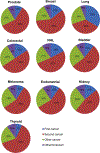Risk of second primary malignancies among cancer survivors in the United States, 1992 through 2008
- PMID: 27377470
- PMCID: PMC6192520
- DOI: 10.1002/cncr.30164
Risk of second primary malignancies among cancer survivors in the United States, 1992 through 2008
Abstract
Background: In the current study, the authors attempted to describe the incidence, most common sites, and mortality of second primary malignancies among survivors of common cancers.
Methods: The authors identified patients aged ≥18 years who were diagnosed with a primary malignancy from the 10 most common cancer sites (prostate, breast, lung, colon, rectum, bladder, uterus, kidney, melanoma, and non-Hodgkin lymphoma) between 1992 and 2008 from Surveillance, Epidemiology, and End Results data. Factors associated with the incidence of second primary malignancies were explored using bivariable and multivariable models, and mortality attributable to first and second primary malignancies was examined.
Results: A cohort of 2,116,163 patients was identified, 170,865 of whom (8.1%) developed a second primary malignancy. Survivors of bladder cancer had the highest risk of developing a second cancer. In a multivariable model controlling for age, race, tumor grade, stage of disease, marital status, educational level, and income, a history of non-Hodgkin lymphoma (hazard ratios of 2.70 and 2.88, respectively, for men and women) and bladder cancer (hazard ratios of 1.88 and 1.66, respectively, for men and women) predicted the highest risk of developing a second cancer. For patients with 2 incident cancers, 13% died of their initial cancer, but greater than one-half (55%) died of their second primary malignancy. Lung cancer was the cause of death in 12% of patients with 2 incident cancers.
Conclusions: Nearly 1 in 12 patients diagnosed with a common cancer developed a second malignancy, the most common of which was lung cancer. Greater than one-half of patients with 2 incident cancers died of their secondary malignancy. The findings from the current study may inform care strategies among cancer survivors. Cancer 2016;122:3075-3086. © 2016 American Cancer Society.
Keywords: Surveillance, Epidemiology, and End Results (SEER) program; epidemiology; screening; second primary neoplasms; survivors.
© 2016 American Cancer Society.
Conflict of interest statement
CONFLICT OF INTEREST DISCLOSURES
The authors made no disclosures.
Figures




References
-
- Siegel RL, Miller KD, Jemal A. Cancer statistics, 2015. CA Cancer J Clin. 2015;65:5–29. - PubMed
-
- American Cancer Society. Cancer Treatment & Survivorship Facts& Figures: 2014–2015. Atlanta, GA: American Cancer Society; 2014.
-
- National Council on Radiation Protection and Measurements. Second Cancers and Cardiovascular Disease After Radiation Therapy. Bethesda, MD: National Council on Radiation Protection and Measurements; 2011. NCRP Report No. 170.
-
- Zagars GK, Ballo MT, Lee AK, Strom SS. Mortality after cure of testicular seminoma. J Clin Oncol. 2004;22:640–647. - PubMed
Publication types
MeSH terms
Grants and funding
LinkOut - more resources
Full Text Sources
Other Literature Sources

